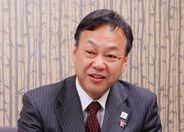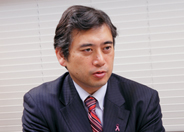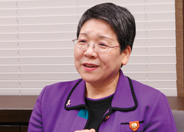Feature: 1. Realizing cancer treatment that allows patients to confront their disease proactively and with hope
Breast cancer is the most common form of cancer in women, with about 40,000 cases diagnosed each year in Japan. Chugai invited two people closely involved in this field, Dr. Seigo Nakamura and Ms. Misako Togashi, to talk with Akio Tanaka, head of Chugai’s Oncology Unit, about current and future issues in cancer treatment and Chugai’s role in realizing patient-centered cancer care.
Chugai’s Initiatives in Cancer Care
- Moderator
- Today I’d like to discuss realizing cancer treatment that allows patients to confront their disease proactively and with hope. First, Mr. Tanaka, please tell us about Chugai’s initiatives so far in cancer drug therapy.
- Tanaka
-
Chugai’s alliance with Roche1 in 2002 enabled us to handle Roche products in Japan and thus provide a number of good medicines to Japanese cancer patients. We have been strengthening our systems year by year while providing appropriate information to those involved in treating cancer. Through these ongoing activities, Chugai gained the top share of oncology sales in Japan for the first time in 2008. We are now advancing various initiatives in line with our vision of "realizing cancer treatment that allows patients to confront their disease proactively and with hope."

1. F. Hoffman-La Roche Ltd. Headquartered in Basel, Switzerland, Roche is a leader in research-focused healthcare with combined strengths in pharmaceuticals and diagnostics.
Evolution of Breast Cancer Treatment
- Moderator
- Dr. Nakamura, please describe how treatment of breast cancer has evolved over the years.
- Nakamura
-
The concept of the disease of breast cancer and methods of treating it started as an area of medicine at the beginning of the 20th century. The mainstream treatment at that time was radical mastectomy, which removed not only the entire breast but also the underlying chest muscles with it in order to remove many of the lymph nodes. In the early 1980s, clinical trials demonstrated that it is not always necessary to cut out a large area of surrounding tissue when surgically removing cancer cells in the breast. Since 1985, treatment combining breast-conserving surgery and radiation therapy has become well established.
Clinical studies of chemotherapy and hormone therapy followed, and gradually the mechanisms that cause cells to multiply became clear. One of the mechanisms identified stimulates cells to grow through a protein called HER22 on the surface of the cell membrane. This discovery resulted in the development of Chugai’s Herceptin®.
New drug research and the clinical development that followed the identification of these mechanisms of cell growth led to significant advances in the treatment of breast cancer. Systemic treatments such as chemotherapy and hormone therapy were introduced, and molecular targeted therapies3 were developed. During the last ten years, we have seen a substantial increase in the types of therapeutic agents available.

2. A protein found on the outer surface of some types of cancer cells, including breast cancer cells. It sends signals to the nucleus of the cell telling the cell to grow.
3. Therapies developed by determining the mechanism of a disease and targeting the specific molecules related to that mechanism.
Progress in Breast Cancer Treatment from a Patient’s Perspective
- Moderator
- Ms. Togashi, from your own experience, how do you feel about the advances in breast cancer treatment?
- Togashi
-
I first learned I had breast cancer in late August 1999. I found a lump about the size of a table tennis ball in my breast, so I had it checked by mammography, and it turned out to be cancer. I was shocked. I was hospitalized the same day and had surgery three days later. The doctor in charge said that because the tumor was more than three centimeters in size, breast-conservation treatment was impossible, so I underwent a simple mastectomy.4 At the time, I was very worried because I knew nothing about breast cancer. I was relieved when test results showed that the cancer had not spread to the lymph nodes, but since the tumor was large, it turned out I had to take a combination of hormone drugs and anti-cancer agents after the surgery.
After the operation, I was terrified that the cancer might recur, so I joined Akebonokai and received a lot of information. Two years later, a regular exam found that the cancer had spread to my lungs, and I thought my life was over. It was then that I went to Dr. Nakamura, who I’d met at a study session, for a second opinion. That was the turning point. He told me I’d have to continue treatment for the rest of my life, and under his direction I switched medications. For the next four years I went for weekly infusions of anti-cancer agents. Dr. Nakamura suggested drug therapy that followed the flow of the standard of care — using a hormone drug until the effect starts to fade, then switching to a different hormone drug. When the drug I had been using no longer worked, I switched to the next one. The treatment was effective for a little more than a year, but it gradually lost its effectiveness and my tumor marker5 levels began to rise again, so I was put on a different anti-cancer agent. Now I’m taking a new hormone drug, and my condition is stable.

- Moderator
- So you have personally experienced the advances in breast cancer treatment during the last ten years.
- Togashi
- Well, Dr. Nakamura told me that many new breast cancer medicines are being developed every day, so if I live even a little longer, everything should work out fine. In fact, I have been helped by the various medicines I’ve used during the last ten years. I suppose I’m fortunate because if my disease had occurred earlier these medicines wouldn’t have been available. Of course, even now I’m not optimistic. But there are still a number of medicines I can use, which gives me a lot of hope.
4. Surgery that removes the breast but leaves the chest muscles in place.
5. A substance that increases as the cancer progresses. In general, a clinical examination uses antibodies to detect such substances that have been liberated into the bloodstream.
What is the Standard of Care?
- Moderator
- Dr. Nakamura, Ms. Togashi says that your treatment followed the standard of care. What exactly is the standard of care?
- Nakamura
- "The standard of care" is the most effective therapy with a scientific basis — that is to say, based on the results of large-scale clinical trials. If another therapy is demonstrated to be more effective in new clinical trials, then it becomes the new standard of care. In Western countries, treatment guidelines for each type of cancer based on the standard of care have been issued since the early 1990s. Japan lagged behind Europe and the United States, but recently high-quality large-scale clinical trials are finally being conducted here too, and treatment guidelines by type of cancer have been compiled. However, there are some medicines that are not yet approved in Japan or are only approved for other indications, so domestic standards have not reached the level of standards of care in other parts of the world. We continue to work every day to close the gap between Japan and other countries.
The Chugai Group’s Initiatives to Realize Patient-Centered Healthcare
- Moderator
- Does the goal of bringing standards of care in Japan to a global level as soon as possible also tie into Chugai’s ambition to realize patient-centered healthcare?
- Tanaka
-
Yes. Closing the gap in standard therapy levels is crucial for realizing patient-centered healthcare. The most effective way of promoting a standard of care is a multidisciplinary team approach.6 We’ve been told by the doctors at the M.D. Anderson Cancer Center7 a world leader in oncology, that pharmaceutical companies are also members of the team. The results of a survey on implementation of standards of care in Japan also clearly showed that supporting such an approach is an effective way of encouraging adoption of a standard of care.
Chugai’s role is to realize patient-centered healthcare by promoting standards of care through effective provision of information and assistance in multidisciplinary team care. To fulfill this role, we have undertaken various initiatives over the last several years, including conveying information to doctors, nurses and pharmacists through scientific conferences and seminars.
- Moderator
- What initiatives is Chugai taking for patients?
- Tanaka
- Patients who suspect or have been told they have cancer are all filled with anxiety, so they need high-quality information. That’s why we launched a website in May 2009 to deliver accurate information to patients and the general public. In addition, for cancer patient associations we hold study sessions and support various events such as the Pink Ribbon campaign and charity concerts.
6. An approach to treatment in which patients themselves participate as a member of a team, and all professionals involved in healthcare contribute their expertise and cooperate on an equal basis.
7. The leading hospital in the U.S. for cancer care. It is famous as the first hospital to adopt a multidisciplinary team approach in which specialists from various disciplines participate in the care of an individual patient.
Contributing to Personalized Treatment as a Global Company
- Moderator
- Finally, what are your requests and expectations for Chugai? Dr. Nakamura?
- Nakamura
-
We are approaching an era of personalized treatment in which cancer diagnosis and treatment will be tailored to each individual patient. The doctor and patient will discuss and decide on the most appropriate course of treatment based on considerations that include the patient’s values and philosophy of life. Even doctors sometimes have difficulty deciding what medicine is most suitable for the patient, but Chugai, with its numerous new molecular targeted therapies, clearly conveys the position of its drugs from the standpoint of the patient. I am very pleased that Chugai is working to implement its vision of "realizing cancer treatment that allows patients to confront their disease proactively and with hope" by developing innovative, useful medicines and making them available to patients as quickly as possible.
My hope is that physicians and pharmaceutical companies can cooperate even more to create a system of care that allows truly necessary medicines to be used when they are needed.
- Tanaka
- What Dr. Nakamura says really drives home the weight of the role we need to fulfill. I think there are still many areas that pharmaceutical companies should research to contribute to personalized treatment. Chugai will work together with Roche to create medicines that benefit both doctors and patients.
- Nakamura
- I appreciate that. As I said earlier, I believe that it is necessary to create a society in which people can receive the same level of treatment anywhere in the world. I look forward to Chugai’s further contributions globally.
- Tanaka
- Global activities are a major theme for us. The establishment of the Chugai Academy for Advanced Oncology in October 2009 is part of that. Our objective in this case is to contribute to cancer care in Japan from a neutral position rather than as a corporate activity. At this facility, we plan to conduct exchanges with some of the world’s leading oncologists, as well as present and develop solutions to various issues.
Providing Accurate Information that Gives Patients Hope
- Moderator
- What is your view as a patient, Ms. Togashi?
- Togashi
- I live every day thankful for the doctors, the hospital staff and the people at the pharmaceutical companies. I always wonder what would have happened to me without those medicines. On the other hand, I am also aware of the reality that many people are dying because new medicines have not been developed in time to save them. I would like drugs that are approved in other countries to be approved quickly in Japan too, so that doctors here are able to use them.
- Tanaka
- Chugai shares your concern. We believe that the social responsibility of drug manufacturers is to make good medicines available as quickly as possible. We are constantly thinking about what we can do for patients and realize that patients in Japan won’t be able to get treatment with a new medicine unless we produce results in clinical trials. We take that responsibility very seriously and are moving development forward every day.
- Togashi
- I have one more request. Chugai-supported events for cancer patients have been increasing, but how about holding seminars for the general public as well? I think it could be a breakthrough program. For example, even though the Pink Ribbon campaign has become more active, the breast cancer screening rate is still not rising. I think it’s important to first teach women about the necessity of getting screened. Then I would also appreciate it if you would provide accurate information that gives women with cancer hope that they can live longer if they get the proper treatment.
- Tanaka
-
As you say, to increase the breast cancer screening rate, we need to do more to communicate information, including appealing to the media. Another crucial point is how to follow the progress of patients. How we can contribute to patients and their families as a pharmaceutical company is a theme we ought to consider.
The themes that Chugai should address are diverse, but we will listen sincerely to everyone’s views while working to realize, as quickly as we can, cancer treatment that allows patients to confront their disease proactively and with hope.
- Moderator
- Thank you all for sharing your thoughts today.






